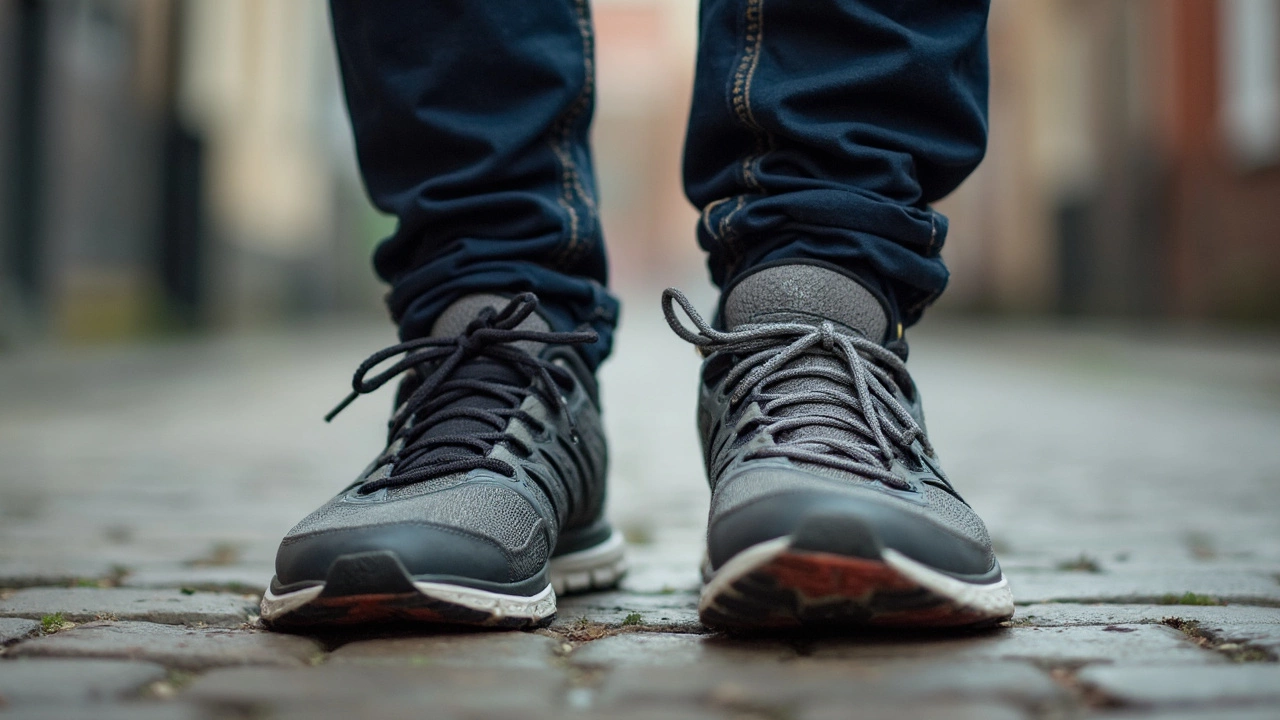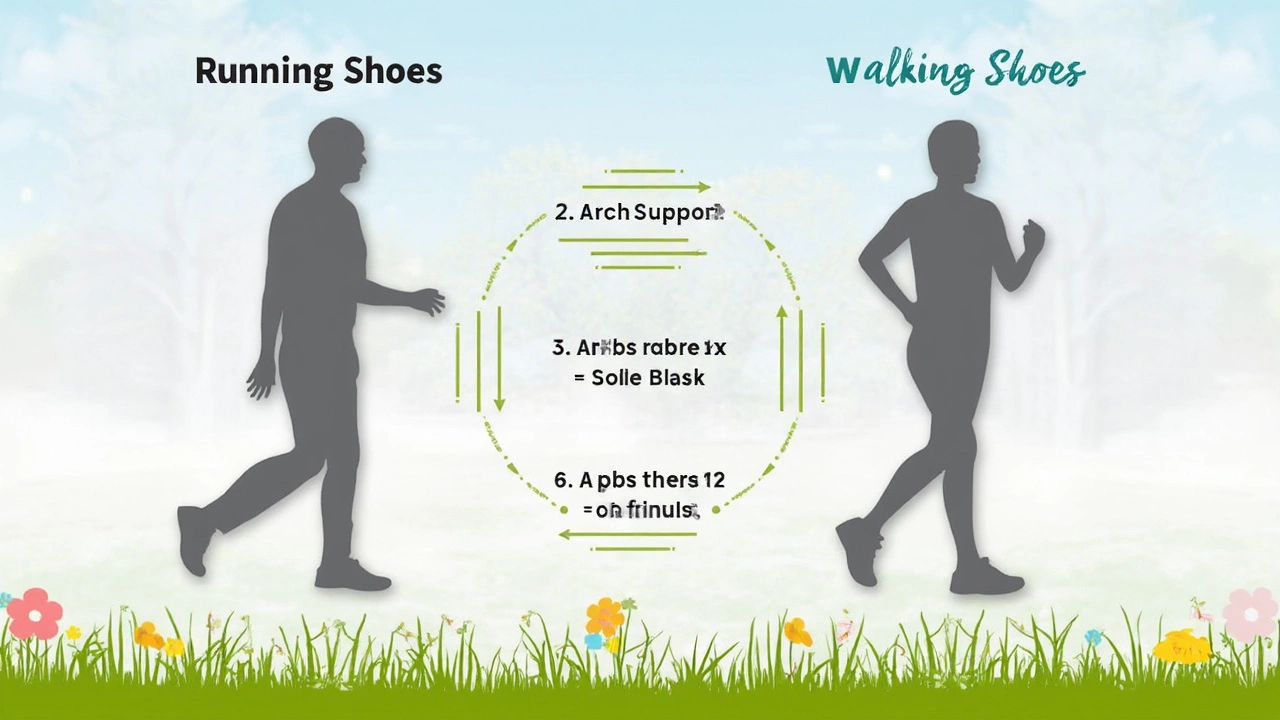Why You Shouldn’t Walk in Running Shoes: What Most People Get Wrong

So you slip on your running shoes for a stroll around the block—big deal, right? But here’s the twist: running shoes aren’t actually great for walking. Most people just assume sneakers are sneakers, but your feet know better.
Running shoes are built to help you move quickly, absorbing shock in all the right places for a pounding run. Walking is a whole different story—the way your foot strikes the ground is slower, flatter, and has totally different pressure points. Stick with running shoes for walks, and you might notice your feet or legs feeling kind of weird or sore after a while.
Ever had a pair of running shoes that felt too bouncy when you were just walking around? That’s because the cushy foam made for running doesn’t always work for a flat-footed walk. You need support in different spots, otherwise your arches and heels could start complaining fast.
- Running Shoes vs. Walking Shoes: The Overlooked Differences
- Risks of Walking in Running Shoes
- How the Wrong Shoe Hurts Your Comfort and Health
- What to Look for in a Good Walking Shoe
- Quick Tips for Choosing the Right Shoes Each Day
Running Shoes vs. Walking Shoes: The Overlooked Differences
Most folks think any sneaker will do the trick, but there’s a world of difference between running shoes and walking shoes. That difference isn’t just about looks—it's all about how your foot moves when you walk versus when you run. The biggest thing? Running is high-impact. Each stride has you slamming down with roughly 2-3 times your body weight. Walking is lower-impact, with less pounding but more constant pressure on different parts of your feet.
Check out some real, clear-cut differences below:
| Feature | Running Shoes | Walking Shoes |
|---|---|---|
| Heel Height | Thicker for shock absorption | Flatter for even foot contact |
| Flex Point | Bends near the midfoot or toe | Bends at the forefoot for natural stride |
| Weight | Lighter to help with speed | Heavier for stability |
| Cushioning | Extra soft for comfort during impact | Moderate to prevent fatigue |
| Material | Often more breathable and less durable | Sturdier upper for everyday wear |
One detail that surprises a lot of people: running shoes curve upward at the toe—it's called a toe spring. That curve helps your foot roll off the ground faster while running. Walking shoes, on the other hand, want your foot to actually stay flat longer as you step. That’s why walking in running shoes can feel a bit awkward or clunky.
And if you’re looking for that buzzword, here it is: running shoes aren’t meant to handle the slow, rolling motion of walking. Over time, using them wrong can make both your shoes and your feet wear out faster.
- If you walk a lot at work, something built just for walking will save your soles—literally.
- If you switch between both activities, it’s worth getting a shoe for each. Double the pairs, double the support.
Risks of Walking in Running Shoes
Walking in running shoes might not seem like a problem at first, but it stacks up risks you might not notice until your feet start acting up. Running shoes are built for a forward, high-impact motion, not for the even, rolling stride you use walking. Because of that, some people end up with aches and pains in places they didn’t expect.
One common issue is sore heels or arches. Running shoes have extra padding in the heel to take the impact of running, but when you walk, your heel strikes more gently. All that cushion can throw off your stride, making your foot land awkwardly. Over time, this can stress your joints or cause blisters and hot spots.
There’s also the risk of foot fatigue. Walking shoes focus on flexible soles, so your foot can roll through each step. Most running shoes are stiffer up front, which means your toes don’t bend the way they should while you walk. After a few days, you might notice tightness in your feet or lower legs just from strolling around the neighborhood.
- Increased chance of blisters from extra movement inside the shoe
- Misalignment of ankles and knees, since the support isn't designed for walking
- Possible arch pain due to lack of flexibility
- Faster wear on your shoes, making them useless for both running and walking
- Foot or leg pain from the wrong kind of shock absorption
Check out the numbers: a study by the American Academy of Podiatric Sports Medicine found that up to 32% of people who use running shoes for regular walking complain of discomfort or minor injuries within the first three months. It’s not just about comfort—walking in the wrong shoes really can set you up for annoying, long-term problems.
| Problem | Percentage of Walkers Affected |
|---|---|
| Heel Pain | 16% |
| Blisters | 25% |
| Arch Fatigue | 12% |
| Knee Discomfort | 11% |
If you’re noticing redness, sore joints, or odd aches, your shoes could be the reason. Small risks add up quick, so don’t brush those early signs aside. Switching to the right pair can save your feet a ton of frustration.

How the Wrong Shoe Hurts Your Comfort and Health
Ever walked a few miles in the wrong shoes and ended up with sore feet, aching knees, or even a weird pain in your hips? That’s not random bad luck. It’s your body telling you that your shoes just aren’t giving you what you need.
Running shoes are made for forward motion, absorbing lots of impact from running strides. But with walking, your step is flatter and lasts longer on the ground. The thick heel padding and arch design in running shoes can throw off your balance if you use them for walking a lot. That means those popular running sneakers might actually lead to blisters, calluses, or even bunions if you’re just strolling around town in them all day.
A study by the American Podiatric Medical Association found that about 60% of foot problems in adults come from wearing the wrong footwear for their daily routines. That’s a lot of preventable aches just because of what’s on your feet.
- Walking in running shoes can increase friction in spots your foot wasn’t designed to rub, especially on longer walks.
- Too much cushion in the wrong area can make you overcompensate, throwing off your natural walking stride.
- Poor fit or the wrong support can lead to shin splints, plantar fasciitis, and even knee or lower back pain.
Just take a look at the common issues people run into with the wrong shoes:
| Problem | What Happens | Why It Happens |
|---|---|---|
| Blisters | Sore, red, sometimes open spots on feet | Too much movement inside the shoe, wrong friction points |
| Knee Pain | Aching, tightness after long walks | Poor support, overcompensation for shoe padding |
| Arch Pain | Soreness under the foot | Lack of support in the right spot for walking |
| Back Ache | Noticed after standing or walking for long stretches | Incorrect posture from wrong heel height or support |
Your choice of running shoes might be great for pounding the pavement, but for walking, there’s a solid chance they’re sending shockwaves up through your body in all the wrong ways. That’s why matching the shoe to the activity makes such a difference in how you feel, not just after a workout, but all day long.
What to Look for in a Good Walking Shoe
Picking out the right walking shoe isn’t all about grabbing whatever looks cool. You want something built for how your foot moves when you walk, not run. Here’s the lowdown on what matters most.
- Flexibility in the Forefoot: Walking means your foot rolls through a full stride, so make sure the shoe bends easily at the ball of your foot. Test this by giving the shoe a light bend with your hands.
- Firm Heel Counter: That’s sneaker jargon for the solid piece that wraps around your heel. You want it stable, not squishy, to keep your foot steady on every step.
- Cushioning Just Right: Forget thick, marshmallow-like soles. Look for moderate cushioning. Too much can mess with your footing; too little and those longer walks will feel rough.
- Flat, Low Heel: A walking shoe should have a barely-there or no heel-to-toe drop, since you don’t need that lift like you do in a running shoe.
- Roomy Toe Box: If your toes can wiggle freely, you’ve found a winner. This keeps things comfortable and helps avoid blisters and calluses.
According to the American Academy of Podiatric Sports Medicine:
“Walking shoes need flexibility and low heels to support the natural stride. A stiff or raised heel can actually make walking uncomfortable and lead to soreness over time.”
Think all this is just hype? Check out the real difference in gear design:
| Feature | Walking Shoe | Running Shoe |
|---|---|---|
| Flexibility | Forefoot (needed for natural foot roll) | More midfoot (for quick push-off) |
| Heel Height | Low or neutral | Usually higher for shock absorption |
| Cushion | Moderate | Extra, especially in heel |
| Support | Focuses on overall stability | Focuses on arch and heel |
And here’s a quick checklist when you’re shopping for a good pair of walking shoes:
- Bend the shoe at the toe—should flex, not twist in half.
- Press the heel; it should feel firm.
- Walk a few steps in the store—no pinching, plenty of room for your toes.
- Try both shoes, since your feet are probably a little different in size.
Don’t be fooled by the hype about special arch gimmicks or super thick soles. The right walking shoes just keep things simple: stable, flexy at the right spot, and comfy for miles.

Quick Tips for Choosing the Right Shoes Each Day
Picking the right shoes for your daily routine saves you from sore feet and even bigger issues down the line. Most people spend way more time on their feet than they realize—so it’s worth getting choosy about what you wear.
Here’s what you want to keep in mind every morning before stepping out the door:
- Think about your main activity—are you walking the dog or hitting the track? Use shoes designed for what you’ll mainly be doing.
- Check the tread. Walking shoes have flatter, more uniform soles, while running shoes feature thicker heels and more curve for toe-off during a run.
- Make sure there’s enough support under your arch and heel—not just squishy foam, but actual structured support that matches your natural foot shape.
- Try on both shoes and walk around in the store. Any rubbing, pinching, or slipping is a red flag. Comfort from the first step is a must.
- Swap out your shoes if you notice aches that weren’t there before, especially in your knees or lower back—it’s often your body’s way of saying "wrong shoes!"
- Don’t trust the size on the box. Different brands run a half size big or small. Go by fit, not the number.
Not sure when to replace your shoes? Check out the numbers:
| Type of Shoe | Recommended Replacement (Miles) | Typical Lifespan |
|---|---|---|
| Walking Shoes | 300–500 miles | 6–12 months |
| Running Shoes | 300–500 miles | 4–8 months |
A good tip: rotate two pairs if you’re swapping between activities. This way, each shoe has time to dry out and decompress. And, honestly, your feet will thank you with fewer blisters and better comfort all day long.
